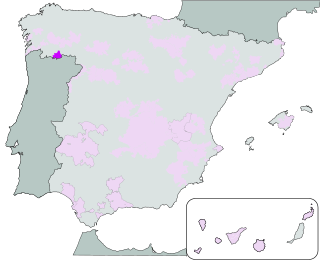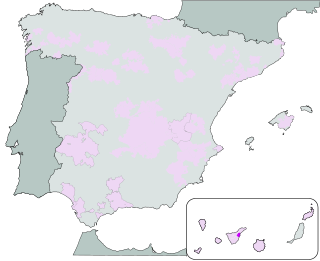Lazy Ballerina is a term used in viticulture. It refers to the trellis that a wine grapevine is grown on. This is a common trellis in Australian wine production particularly in the McLaren Vale wine region of South Australia.
Lazy Ballerina is a term used in viticulture. It refers to the trellis that a wine grapevine is grown on. This is a common trellis in Australian wine production particularly in the McLaren Vale wine region of South Australia.

A vineyard is a plantation of grape-bearing vines, grown mainly for winemaking, but also raisins, table grapes, and non-alcoholic grape juice. The science, practice and study of vineyard production is known as viticulture. Vineyards are often characterised by their terroir, a French term loosely translating as "a sense of place" that refers to the specific geographical and geological characteristics of grapevine plantations, which may be imparted to the wine itself.

Bobal is a variety of Vitis vinifera, a red grape used in winemaking. It is native to the Utiel-Requena region in Valencia, Spain. The presence of Bobal in Utiel-Requena was documented in the 15th century in "Espill o llibre de les dones" by Jaume Roig. The name derives from the Latin bovale, in reference to the shape of a bull's head.

Méntrida is a Spanish Denominación de Origen Protegida (DOP) for wines covering many municipalities in the northeast corner of the province of Toledo and which is divided into three distinct areas: Talavera, Torrijos and Sagra-Toledo, with over 26,000 hectares under vines, the majority (71%) being in Torrijos.

Ribera del Júcar is a Spanish Denominación de Origen Protegida (DOP) for wines located in the province of Cuenca along the banks of the River Júcar and covers 7 municipalities.

Pla de Bages is a Spanish Denominación de Origen Protegida (DOP) for Catalan wines, located in the province of Barcelona, and is one of the smallest DOPs in Spain, covering less than 500 hectares. It is also one of the newest having acquired its official status in 1997.
Guijoso is a Vino de Pago from Spain. This is the highest category on the quality scale of Spanish wines and means that in addition to having a proven track record of consistent quality, the wines have to be both produced from estate-grown grapes and also have to be processed and aged in a winery (bodega) located on the estate.

Monterrei is a Spanish Denominación de Origen Protegida (DOP) for wines located in the southeast corner of the province of Ourense in. It covers the municipalities of Verín, Monterrei, Oimbra and Castrelo do Val.

Pla i Llevant is a Spanish Denominación de Origen Protegida (DOP) for wines located on the island of Majorca, Balearic Islands, Spain. The name in the Catalan or Majorcan language means "plain and east coast."

Abona is a Spanish Denominación de Origen Protegida (DOP) for wines located on the southern coastline of Tenerife,, and acquired its DO in 1996.

Vietnamese wine is wine produced in Vietnam. The area was first cultivated for viticulture during the French colonial rule of the region in the late 19th century. The region's tropical climate was ill-suited for the type of Vitis vinifera that the French colonists were used to and the wine industry turned its attention to fruit wine production. The late 20th century saw a renewed focus on the development of Vitis vinifera with the assistance of flying winemakers from regions like Australia. In 1995, a joint venture with Australian winemakers started an aggressive planting scheme to reintroduce international grape varieties like Cabernet Sauvignon and Chardonnay to land that was until recently littered with landmines left over from the Vietnam War.
Soubès is a commune in the Hérault department in Occitanie in southern France, situated on a hill near the confluence of the Brèze and Suberbet rivers.
Richard Smart is an Australian viticulturalist and leading global consultant on viticulture methods, who is often referred to as "the flying vine-doctor". He is considered responsible for revolutionising grape growing due to his work on canopy management techniques.

Txakoli de Álava (Basque) or Chacolí de Álava (Spanish) is a Spanish Denominación de Origen Protegida (DOP) for wines, located around the towns of Amurrio, Llodio, Artziniega, Okondo and Aiara in the province of Álava, Basque Country, Spain.

In viticulture, the canopy of a grapevine includes the parts of the vine visible aboveground - the trunk, cordon, stems, leaves, flowers, and fruit. The canopy plays a key role in light energy capture via photosynthesis, water use as regulated by transpiration, and microclimate of ripening grapes. Canopy management is an important aspect of viticulture due to its effect on grape yields, quality, vigor, and the prevention of grape diseases. Various viticulture problems, such as uneven grape ripening, sunburn, and frost damage, can be addressed by skillful canopy management. In addition to pruning and leaf trim, the canopy is often trained on trellis systems to guide its growth and assist in access for ongoing management and harvest.
Precision viticulture is precision farming applied to optimize vineyard performance, in particular maximizing grape yield and quality while minimizing environmental impacts and risk. This is accomplished by measuring local variation in factors that influence grape yield and quality and applying appropriate viticulture management practices. Precision viticulture is based on the premise that high in-field variability for factors that affect vine growth and grape ripening warrants intensive management customized according to local conditions. Precision viticulture depends on new and emerging technologies such as global positioning systems (GPS), meteorologic and other environmental sensors, satellite and airborne remote sensing, and geographic information systems (GIS) to assess and respond to variability.

Valle de Güímar is a Spanish Denominación de Origen Protegida (DOP) for wines located along the south-eastern coastline of Tenerife, and acquired its DO in 1996.

Uclés is a Spanish Denominación de Origen Protegida (DOP) for wines located in the region of Castile-La Mancha, (Spain), around the town of Uclés in the west of the province of Cuenca and in the northeast of the province of Toledo.

The Upper Mississippi River Valley AVA is an American Viticultural Area covering 29,914 square miles located along the Upper Mississippi River and its tributaries in northwest Illinois, northeast Iowa, southeast Minnesota and southwest Wisconsin. Certified by the United States Department of the Treasury's Alcohol and Tobacco Tax and Trade Bureau on July 22, 2009, it is the largest AVA in the United States. The AVA encompasses an area 50 times larger than the Bordeaux wine regions of France.

The use of vine training systems in viticulture is aimed primarily to assist in canopy management with finding the balance in enough foliage to facilitate photosynthesis without excessive shading that could impede grape ripening or promote grape diseases. Additional benefits of utilizing particular training systems could be to control potential yields and to facilitate mechanization of certain vineyard tasks such as pruning, irrigation, applying pesticide or fertilizing sprays as well as harvesting the grapes.

The Hunter Valley is one of Australia's wine regions. Located in the state of New South Wales and first cultivated in the early 19th century, it was one of the first Australian wine regions. As well as Hunter Valley Sémillon, the region produces wine from a variety of grapes including Shiraz, Chardonnay, Cabernet Sauvignon and Verdelho.